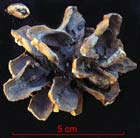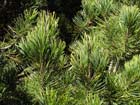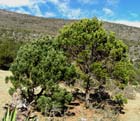Pinus johannis
M.-F. Robert 1978
Common names
Johannis pine, dwarf piñon; piñon, piñonero [Spanish].
Taxonomic notes
Type: Mexico, Zacatecas, 3 km west of Concepcion del Oro at Puerto el
Dique (24°37' N, 101°28' W), on limestone in an open forest of Pinus cembroides and Agave sp., elev. 2700 m, 1975.09.24, Robert 5936 B (holo P, iso MPU, TLJ, ENCB, INIF). Syn: P. culminicola var. johannis (R-P.) Silba 1985 (Farjon & Styles 1997).
The validity of this taxon was long disputed, with many authors placing it within P. cembroides. However, see P. cembroides for a discussion of the systematics of the piñons, including the finding that molecular evidence strongly supports recognition of P. johannis at species rank, with P. discolor as its sister species. Indeed, the two species look so similar that the easiest way to distinguish them is with a map; their ranges are disjunct. Also, this is the only dioecious pine species (Flores-Rentería et al. 2013).
Description
Dioecious (the only dioecious pine; Flores-Rentería et al. 2013) shrub or tree, 2-3(-4) m tall, multi-stemmed, rarely with a single trunk. Crown low, dense and rounded, spreading, with branches extending outward as much as 3-4 m. Bark in young trees smooth and gray; in older trees rough and scaly, but not deeply furrowed or ridged. Twigs dark gray, rough, the bases of the leaf bracts somewhat decurrent. Leaves (2-)3(-4) per fascicle, 3-5 cm long, 0.9-1.2 mm thick; flexible, margins entire, stomata present only on the ventral surfaces, with a distinctive variegated appearance because the dorsal surface is dark green and the ventral surfaces glaucous white. Resin canals 2, external, dorsal; vascular bundle single. Fascicle sheaths orange-brown, 3 mm long, fading gray, and curled backward into a rosette; later occasionally deciduous. Cotyledons (6-)9(-11). Seed cones in first year brown, 9-11 × 5-7 mm, borne singly or in pairs on short slender peduncles. Cones at maturity chestnut brown, resinous, oblong, 3-4(-4.5) × 2-3 cm when closed, 4-5.5 cm wide when open, opening at maturity and soon deciduous. The peduncle is 3-4 mm long, falling with the cone. Cone scales are thin and stiff, the apophyses irregularly rhomboid, small, thin, flat or slightly raised, 10-15 mm wide, with a weak transverse ridge; umbo dorsal, depressed, the prickle minute and soon deciduous. Only the central (3-)8-15 scales are seed-bearing, those at the base and apex of the cone generally very small and sterile. Seeds dark orange-brown with a rudimentary 0.5-1 mm wing that remains in the cone after seed release; about 11-14 × 10 mm, the seed coat or shell 0.5-1.0 mm thick, hard; about 2,200 seeds/kg; endosperm white; edible. Wood pale yellowish brown, used only for fuel (Perry 1991, M.P. Frankis field notes, NE Mexico 1991.11).
Distribution and Ecology
Mexico: Coahuila, Nuevo León, San Luis Potosi, and Zacatecas (collection sources). Scattered in the higher ranges at 1700-2800 m elevation (Perry 1991; M.P. Frankis field notes, NE Mexico Nov 1991; Farjon & Styles 1997). The type locality is "only in a very limited area near the towns of Concepción del Oro and Mazapil, state of Zacatecas. More recently a number of small populations have been reported in western Coahuila and in the area between the towns of Miquihuana and Aramberri, Nuevo León... In Nuevo León they were growing with P. nelsoni at about 2,800 m" (Perry 1991). Perry (1991) describes the Concepción del Oro stand as occurring at 2,700 m on a steep slope of practically bare limestone, in the company of P. cembroides. The area has 300-400 mm annual precipitation and average annual temperature of 16°C. Frosts are common during December and January. Hardy to Zone 8 (cold hardiness limit between -12.1°C and -6.7°C) (Bannister and Neuner 2001).
Pines of the Pinus cembroides complex. Brown is P. johannis. Purple diamonds are P. cembroides ssp. cembroides, purple stars are P. cembroides ssp. orizabensis, green is P. culminicola, blue is P. discolor, red is P. lagunae, and gold is P. remota. Based on GBIF.org downloads https://doi.org/10.15468/dl.pfuj4k (P. culminicola), https://doi.org/10.15468/dl.vvju45 (P. remota), and https://doi.org/10.15468/dl.5k7x9y (all other taxa), accessed 2023.03.09, with location uncertainty <10 km, and location duplicates removed.
Because they do not regard this as a valid species, the IUCN has not classified it as a sensitive taxon. It certainly warrants such classification due to its rarity, its uniqueness, and its vulnerability to exploitation and habitat loss associated with development activity.
Remarkable Specimens
The tallest seen by M.P. Frankis (field notes, 1991.11) in NE Mexico was about 4 m tall, on a single erect stem about 15-20 cm dbh, beside a dirt road on the west slope of Cerro Peña Nevada, 23°49'N 99°53'W, at 2680 m altitude (M.P.Frankis 179, 15 Nov 1991 [cited in error in (Farjon and Styles 1997) as at 3500 m]). Most were 2-3.5 m tall, not erect, and branched close to the base, similar to P. culminicola. Trees in the stand that I visited, shown in photographs at right, were about the same size.
The species is probably not long-lived; no thick stems nor any other indication of great age have been seen on specimens in the field (M.P. Frankis field notes, NE Mexico 1991.11; and my observations in 2007.02).
Ethnobotany
"The branches of this small piñon are occasionally used for firewood and the seeds are collected for food" (Perry 1991).
With its very attractive blue-green foliage, it is potentially a valuable slow-growing ornamental species for small gardens in arid areas, but it is scarcely in cultivation yet. USDA hardiness zone 8.
Observations
The type locale "is not difficult to find by following Mexico Highway 54 south from Saltillo for about 112 km. Look for a turn off on the right to Concepción del Oro. The road is paved to Concepción del Oro (about 3 km), but from there to Mazapil it is narrow, steep and unpaved. Though the pines can be found only a few kilometers from Concepción del Oro, it would be best to plan collections during the dry winter months, November-February" (Perry 1991).
It can also be seen scattered in the high valleys between San Antonio de las Alanzas and Monterrey around the Nuevo León / Coahuila border; these populations have only been discovered in recent years and are not mapped by Perry (1991), but are shown by Farjon and Styles (1997). At some of these sites it is separated from populations of P. culminicola by under 5 km and 400 m of altitude; despite this close proximity, no hybrids have been observed between these closely related taxa. Throughout its range, it also often occurs intimately mixed with P. cembroides, but again, no evidence of hybridisation has been found.
Remarks
P. johannis was named after Mlle. Robert's fiancé, Johann Passini, whom she later married; she published subsequent papers first as M.-F. Robert-Passini and then as M.-F. Passini.
Citations
Flores-Rentería, Lluvia, F. Molina-Freaner, A.V. Whipple, C.A. Gehring, and C.A. Domínguez. 2013. Sexual stability in the nearly dioecious Pinus johannis (Pinaceae). American Journal of Botany 100(3):602–612. doi:10.3732/ajb.1200068.
Robert, M.-F. 1978. Une nouveau pin pignon Mexicain: Pinus johannis. Adansonia ser. 2, 18:365-373. Available: Biodiversity Heritage Library, accessed 2023.03.09.
Much of this page was prepared by M.P. Frankis, 1999.02.
See also




